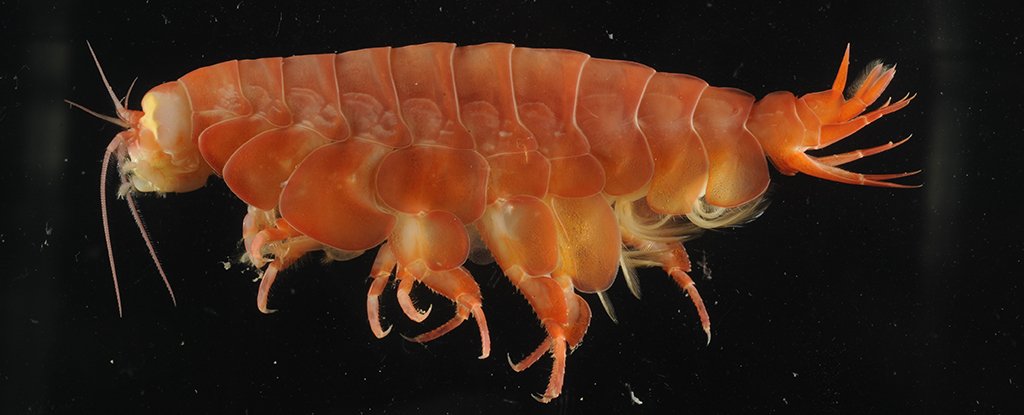Products You May Like
Discovering a new species and placing it on the tree of life is a big responsibility. I have been fortunate to name four species from some of the deepest, most remote and least sampled parts of the ocean. Each new species helps us uncover how life thrives in the hadal zone (anywhere deeper than 6,000 meters or 3.7 miles). Now, let me introduce you to Eurythenes atacamensis.
E. atacamensis is an amphipod, a type of crustacean closely related to a shrimp, endemic to the Peru-Chile Trench (also known as the Atacama Trench). Measuring more than 8 centimeters (3 inches) in length, it is nearly twice the size of its nearest relative, making it a giant.
Spanning an extensive vertical range, juveniles and adults can be found in the trench between 4,974 to 8,081 meters. This includes the deepest point, known as Richard’s Deep.
It is one of the most abundant members of the trench community, joining a trio of snailfish and long-legged, spider-like isopods. As a scavenger, this amphipod plays a critical role within the food web by intercepting and redistributing food sinking down from above.
They quickly detect and consume new carrion, like the mackerel bait we used to coax individuals into the trap. Unfortunately, they can accidentally ingest microplastics too.
Their home is one of 35 trenches that reach hadal depths. These trenches are formed by a geologic process called subduction (where one tectonic plate is forced under another causing the ocean floor to quickly plunge). The volume of the Atacama Trench is almost the same as the neighboring Andes mountain range, also created by the tectonic subduction zone.
Compared to the conditions at the surface, the hadal (or deep-sea) environment seems extreme. It is pitch black with water temperatures varying between 1°C and 4°C (33.8 and 39.2 °F) at the deepest points.
The hydrostatic pressure at hadal depths ranges from 600 to 1,100 atmospheres – equivalent to placing one-tonne on the end of your finger.
But this environment is entirely normal to the organisms that live there. Hadal inhabitants have a suite of biochemical, morphological and behavioral adaptions that allow them to thrive in the trenches. Studying these ecosystems is not an easy task – which is why the hadal zone has been understudied compared to shallower parts of the ocean.
In 2018 two international research expeditions focused on the southern portion of the Atacama Trench. Scientists first set off on the Chilean vessel, RV Cabo de Hornos, to study the deepest part of the trench, Richard’s Deep, as part of the Atacamex expedition.
A month later, scientists on the German vessel, RV Sonne, studied the wider trench ecosystem, sampling from 2,500 metres to Richard’s Deep.
During the expeditions, unmanned submersibles called landers were deployed. Landers were equipped with robust deep-sea imaging equipment and baited traps to bring animals up for closer inspection.
Both expeditions were a success and collected hundreds of hours of footage and thousands of amphipods – including E. atacamensis – as well as a new species of snailfish, affectionately nicknamed the “Little Purple Lovely” until its official scientific name is decided.
Once the specimens were back on land, the detailed work to sort, measure, identify and describe new species commenced. E. atacamensis is a member of a well-studied deep-sea genus (Eurythenes), which is notorious for what is known as cryptic speciation. In other words, when it is hard to visually tell one species from another.
The fantastic photographs of E. atacamensis were actually taken back in a 2009 expedition to the trench.
At the time, it was first identified as E. gryllus. With the new 2018 specimens, we accounted for cryptic speciation by applying an integrative taxonomy approach – pairing traditional morphology (the detailed study of an organism’s shape) with DNA barcoding. This latest research showed it was actually a different and undescribed species.
This taxonomic process helped us categorize organisms so we could more easily communicate the biological information. Together, the detailed visual assessment and genetics gave us a clear result that E. atacamensis was a new species.
Once confident in the data, we selected several individuals to be described and illustrated. These individuals are called type specimens – the most important of which is the holotype or the “name-bearing” specimen. We chose the name atacamensis in tribute to its home.
This discovery is another piece in the puzzle of understanding the world that we live in and the subtle interactions between organisms and their environment. It helps us understand how life thrives in the deepest parts of the ocean, under conditions that seem impossible to terrestrial mammals like us.
It also gives us a glimpse into the hadal zone – not an extreme habitat bereft of life, but one filled with extraordinary biodiversity.![]()
Johanna Weston, PhD Marine Science candidate, School of Natural and Environmental Sciences, Newcastle University.
This article is republished from The Conversation under a Creative Commons license. Read the original article.
